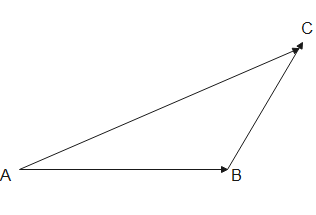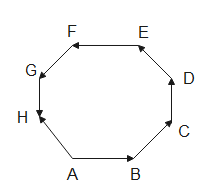
The polygon law of vector addition is simply an extension of ____________
(A). Parallelogram law of vector addition
(B). Triangular law of vector addition
(C). Both A and B
(D). None of the above
Answer
551.4k+ views
Hint: Vector is a quantity with both magnitude and direction in space. They can be moved about in space and can be added subtracted, multiplied etc. There are three main laws for vector addition; triangular law of vector, polygon law and the parallelogram law of vector addition.
Complete step-by-step solution:
A vector is a quantity that has magnitude as well as a direction in space.
Algebraic operations can be done on the vectors and the resultant can either be a vector or a scalar. When two vectors are added, the resultant is a vector quantity. There are three main rules of vector addition; one of them is the triangular law of addition.
The triangular law of vector addition states that when the vector vectors to be added are placed such that they represent two sides of a triangle taken in the same order, then the third side represents the resultant taken in opposite order. Therefore,

$\overrightarrow{AB}+\overrightarrow{BC}=\overrightarrow{AC}$
Triangular law of vector addition can be further extended for the addition of more than two vectors.
When more than two vectors are to be added such that all the vectors are in the same order, make an open figure, then their resultant is the side which closes the figure taken in the opposite order. Therefore,

$\overrightarrow{AB}+\overrightarrow{BC}+\overrightarrow{CD}+\overrightarrow{DE}+\overrightarrow{EF}+\overrightarrow{FG}+\overrightarrow{GH}=\overrightarrow{AH}$
Therefore, the polygon law of vector addition is simply an extension of triangular law of vector addition.
Hence, the correct option is (B).
Note:
Only the scalar product or dot product of two vectors give a scalar quantity as resultant. The other law of vector addition is the parallelogram law of vector addition which states that When two vectors are taken in opposite order such that they form two sides of a parallelogram, then their resultant is given by the diagonal of the parallelogram.
Complete step-by-step solution:
A vector is a quantity that has magnitude as well as a direction in space.
Algebraic operations can be done on the vectors and the resultant can either be a vector or a scalar. When two vectors are added, the resultant is a vector quantity. There are three main rules of vector addition; one of them is the triangular law of addition.
The triangular law of vector addition states that when the vector vectors to be added are placed such that they represent two sides of a triangle taken in the same order, then the third side represents the resultant taken in opposite order. Therefore,

$\overrightarrow{AB}+\overrightarrow{BC}=\overrightarrow{AC}$
Triangular law of vector addition can be further extended for the addition of more than two vectors.
When more than two vectors are to be added such that all the vectors are in the same order, make an open figure, then their resultant is the side which closes the figure taken in the opposite order. Therefore,

$\overrightarrow{AB}+\overrightarrow{BC}+\overrightarrow{CD}+\overrightarrow{DE}+\overrightarrow{EF}+\overrightarrow{FG}+\overrightarrow{GH}=\overrightarrow{AH}$
Therefore, the polygon law of vector addition is simply an extension of triangular law of vector addition.
Hence, the correct option is (B).
Note:
Only the scalar product or dot product of two vectors give a scalar quantity as resultant. The other law of vector addition is the parallelogram law of vector addition which states that When two vectors are taken in opposite order such that they form two sides of a parallelogram, then their resultant is given by the diagonal of the parallelogram.
Recently Updated Pages
Master Class 11 Economics: Engaging Questions & Answers for Success

Master Class 11 English: Engaging Questions & Answers for Success

Master Class 11 Social Science: Engaging Questions & Answers for Success

Master Class 11 Biology: Engaging Questions & Answers for Success

Class 11 Question and Answer - Your Ultimate Solutions Guide

Master Class 11 Business Studies: Engaging Questions & Answers for Success

Trending doubts
10 examples of friction in our daily life

One Metric ton is equal to kg A 10000 B 1000 C 100 class 11 physics CBSE

Difference Between Prokaryotic Cells and Eukaryotic Cells

1 Quintal is equal to a 110 kg b 10 kg c 100kg d 1000 class 11 physics CBSE

Explain zero factorial class 11 maths CBSE

What is a periderm How does periderm formation take class 11 biology CBSE




